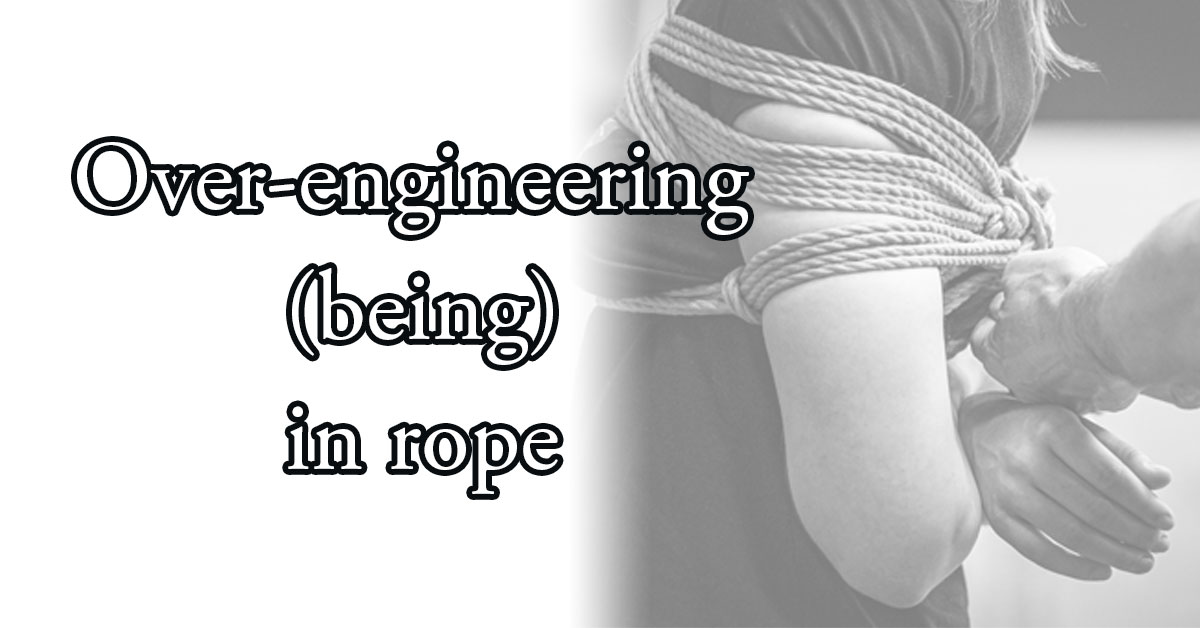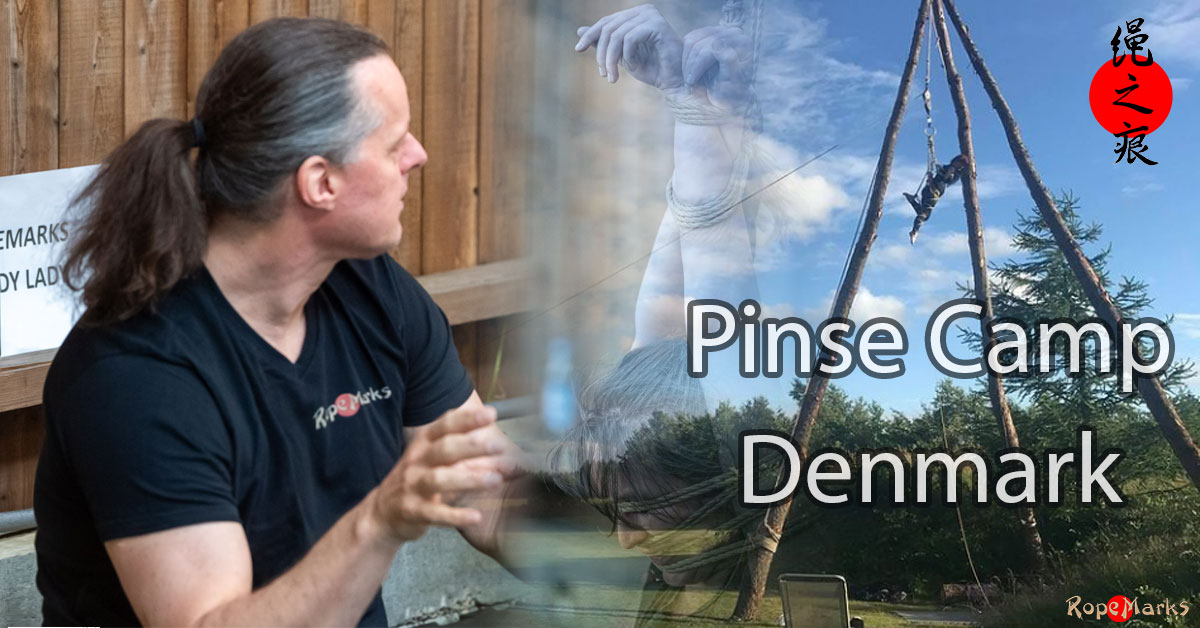Something not directly related to Japanese bondage, breast bondage. However, big breast are a Japanese fetish, actually anything Western is “hot” in the East, just as anything Japanese is “hot” in the West.
Anyway, Breast bondage; it is not something we do often, but we have done our research on this and used it. These are our guidelines:
- as with any situation where tight ropes are used it is possible that blood flow will be restricted too much, which can cause pain and lasting damage if care is not used,
- some discomfort can be expected in the early stages of exploration,
- tightness, swelling and redness are common,
- breasts should never become numb,
- breasts should never become blue/purple.
Photos of breast bondage sometimes show that the breasts have turned blue/purple. If this happens, blood flow may have been restricted too much and it may be safer to remove or loosen the ropes.
Remember: different women have different sensitivity to various areas of their breasts. Some have very sensitive nipples and areola, others do not. Similarly the supporting heavy tissue in some is sore, and easily bruised, while others can take a lot of “attention”. Explore the sensitivity of your partner before you apply a breast bondage.
We feel that breast bondage must only be done when the proper, medical, information about breasts is present with all participating parties. Since we are no, medical, expert on breast bondage we’ve reproduced an article that gives you a jump start on things to look out for. Read it carefully and don’t think to light about breast bondage.
Fat Necrosis
Fat Necrosis is the destruction of fat cells in the breast due to trauma (injury) or hypoxemia (deprivation of oxygen). Special care must be taken with fatty breast tissue because the blood supply to fat is always poor. Lack of oxygen or an inadequate blood supply causes the cells to die and release particles of fat. The remaining tissue may become hard or calcified. (1A)
The breast is not all fat, it also has supporting structures and milk ducts. Other areas of the body have large fatty areas, such as the buttocks, which can experience trauma-induced fat necrosis. However, the breasts are the only largely-fat area that can be isolated and tied up, restricting necessary blood supply.
Fat Necrosis mimics breast cancer both clinically and mammographically. There is no way to tell a cancerous lump from fat necrosis without a biopsy, so the lump must be surgically removed. (3, 16) Fat necrosis doesn’t cause breast cancer, but you can’t assume that a lump in your breast was caused by scarring – it must be removed in order to be sure it’s not cancer.
One woman reported that fatty tissue in her breast had been ruptured during a minor car accident, in a line that was caused by her safety belt. The accident had happened 4 years prior to her mammogram and had been so minor that neither the cars or the people were hurt, and she had experienced no pain and had no bruising. Yet the doctor explained that the milk ducts and supporting structures in the breasts form scar tissue very easily. This makes the detection of breast cancer more difficult. Since 1 in 9 women get breast cancer (some doctors say 1 in 11) and early detection means the difference between life and death, you must get regular mamograms and monthly breast exams to discover any lumps in your breasts. (13)
Symptoms of Fat Necrosis:
- The lumps are painless, round and firm, formed by the damaged and disintegrating fatty tissues. (2)
- The skin around the lumps can look red or bruised. (2)
- The area may or may not be tender. (10)
- One of the common symptoms of both fat necrosis and breast cancer is dimpling in the breast. (17)
- Severe scarring within the breast may cause nipple retraction. (11)
- A clear liquid with a yellow or brownish color may drain from the nipple.(12)
- Large breasts have more of a tendency to form fat necrosis when traumatized than smaller breasts. (1A)
Prevention:
Trauma, which is a blow to the fat tissue, can occur under a variety of circumstances. The degree of injury depends on the force of the blow and its direction. Trauma can also be caused by twisting the tissue, which may happen when rope is being wound around the breast. (18) Pain is probably the best indicator that damage is being done.
Hypoxemia, too little oxygen in the blood caused by poor circulation, is a leading cause of cell death and fat necrosis. (12) The point of no return is difficult to define at the level of the cell. On the most basic medical level, the point of irreversible damage in fat cells occurs in as little as 15-60 minutes. (11)
However, recognizable morphologic changes may not be apparent for a few hours. It requires 8 to 24 hours for the nuclear changes to occur. Meanwhile, the cytoplasm has passed through the stages of swelling and becomes transformed into an acidophilic, granular, opaque mass. (11)
Since it’s difficult to tell by observation alone when the “point of no return” has been hit, a reasonable rule of thumb is: with tight bondage (ie. a finger can’t easily be inserted between the flesh and the rope) leave the rope tied for less than 15 minutes. Then fully release the rope to allow the blood to re-oxygenate the fat tissue (this may take ten to fifteen minutes because the blood supply to fat is very poor.)(1A)
Trevor Jacques in “On the Safe Edge” recommends that you should always able to put a finger between the rope and the skin to prevent cutting off the circulation during bondage. (20) If the rope is loose enough to insert one index finger to the knuckle (your choice, male or female finger!) then you should be able to safely leave the rope on for 30 minutes. (19)
If the rope is loose enough for two or three fingers, you can go up to 45 minutes. It’s best not to tie the breasts for more than an hour before releasing the rope to allow thorough circulation to occur. (11)
1/4 inch rope and up is usually recommended for any type of bondage where the rope touches the skin. Pat Califia advises in “Sensuous Magic” that narrower material than 1/4 inch (like string or cord) shouldn’t be used because it can cut the skin. (21) Race Bannon in “Learning the Ropes” reminds us that breathing should never be restricted by rope, so ask the bottom take a deep breath before tying the anchor rope around her chest. (22)
Most leather-s/m technique books advise against suspending a body with rope. Ideally, if rope is to be used for suspension, a web is created so the body is supported in numerous places and care should be given so the knots don’t put pressure on the skin. Thus, it is not possible to safely suspend someone from their breasts. The cut-off in circulation is exponentially higher because of the added weight of the body during suspension, and there is a significant potential for damaging the fragile supporting structures and the milk ducts of the breasts.
Hematoma
A hematoma is a swelling filled with blood that is caused by trauma. Hematoma can cause scarring in the breast.(1A, 3) A small hematoma usually absorbs on its own but a large one requires surgery.
Hematoma most commonly form when the skin has been broken. A hematoma is an excellent medium for the growth of bacteria.(1) The inflammatory response results from traumatic rupture of adipocytes which release their contents, often followed by fat necrosis that causes scar formation. (9)
Symptoms of Hematoma:
- Bruising or contusion is followed by swelling caused by the passage of fluid through the walls of damage capillaries. (18)
- Bacteria can cause infected fat tissue to appear black because of deposits of iron sulfate from the degraded hemoglobin. (8)
- You may have a fever as a sign of infection. (1)
Prevention:
A hematoma is usually caused by broken skin, yet it is possible for a blow to cause a hematoma. Like fat necrosis due to trauma, the degree of injury depends on the force of the blow and its direction. A hematoma can also be caused by twisting the tissue, which may happen when rope is being wound around the breast. (18) Pain is probably the best indicator that damage is being done.
Fibrocystic Breast Disease
Fibrocystic breasts are prone to the formation of both fluid-filled cysts and fibrous tissue. Typically the breasts have a lumpy feel, and both lumpiness and tenderness increase in the week prior to menstruation. Tight, frequent breast bondage or long painful stimulation should be avoided, as these can increase the formation of breast cysts. (6)
Fibroadenomas
Fibroadenomas are benign breast growths which usually occur in young women. They are a very common cause of breast masses in the 15 to 25 age group. Fibroadenomas also account for 15% of all palpable breast masses in women 30-40 years of age. Clinically, these growths are smooth, firm and easily movable masses. It is generally accepted practice that suspected fibroadenomas should be removed in women over the age of 25. These growths are not associated with an increased risk of breast cancer. (15)
Breast Cancer
Breast cancer is a complex and devastating disease, and the most frequently diagnosed cancer in American women. In 1995, there will be an estimated 182,000 new cases of breast cancer diagnosed in this country and an estimated 46,000 deaths. The cause of cancer is not known at this time. (5)
Fibrocystic breast disease, fibroadenoma, fat necrosis and hematoma are all benign breast conditions that may lead to biopsy due to the fact that cancers cannot be identified by palpation alone. (7) That’s why it is common sense to get anything usual checked immediately by a doctor. If it isn’t cancer your mind will be put at rest. If it is, it can be treated as quickly as possible.
Questions to Ask:
The following questionnaire was taken verbatim from “Breast Lumps, Cancer & Self-Exam,” 1996, by the American Institute of Preventive Medicine. (14) If you answer yes to any of these questions, go see a doctor:
- Do you see or feel any lumps, thickening or changes of any kind when you examine your breasts? For example, is there dimpling, puckering, retraction of the skin or change in the shape or contour of the breast?
- Do you have breast pain or a constant tenderness that lasts throughout the menstrual cycle? If you normally have lumpy breasts (already diagnosed as being benign by your doctor), do you notice any new lumps or have any lumps changed in size or are you concerned about having benign lumps?
- Do the nipples become drawn into the chest or are they inverted totally, change shape or become crusty from a discharge?
- Is there any non-milky discharge when you squeeze the nipple of either breast or both breasts?
- Do you have a family history of breast cancer which leads you to be concerned, even if you don’t notice any problems when you examine your breasts?
- Have you had recent trauma which resulted in a breast lump being formed?
Susan Wright
June 1998
This document brings together information available on breast trauma and hypoxemia, usually quoting verbatim from the sources. Most of the information in this article was found on the internet and is accessible by everyone (check the footnotes for the URL of the original source). Sources include: medical doctors who perform breast reductions, breast implants and plastic surgery; FAQs from the National Cancer Institute and Long Island Breast Surgery; and study notes from Cornell University and Emory University.
References:
1. Patrick Hudson MD PA, Plastic Surgery, 505/880 0779
1A. Fat necrosis after breast reduction
2. National Cancer Institute (NCI)
3. http://www.trimaris.com/ussw/medical/lesions.html
4. Women’s Diagnostic Cyber, Breast disfigurement
5. The Cancer Information Service (CIS), a program of the National Cancer Institute, 1–800–4–CANCER (1–800–422–6237).
6. FIBROCYSTIC BREAST DISEASE, What is It?
7. Section: Letter of the Week, Heme/Onc, Ob/Gyn; Subject: Atypical Cells on Breast Biopsy and Breast Cancer
8. Carson DA, Riberio JM, Apoptosis and disease. Lancet (1993) 341:1252; Lane DP. A death in the life of p53. Nature (1993) 362:786; Culotta E, Koshland DE. p53 sweeps through cancer research. Science (1993)262:1958
9. © 1997 Applied Medical Informatics Inc.
10. Site concept and development – Orbis Broadcast Group, Interactive Media
11. Principles of Drugs and Disease, PHAR 603; Team Leader: Richard Stull, Ph.D., Cell Death, Autolysis, Necrosis
12. Cell injury and Adaption study notes
13. Posted by Anoria on February 05, 1998 at 01:09:10, The Salon WWW Board
14. Breast Lumps, Cancer & Self-Exam, 1996, American Institute of Preventive Medicine
15. Long Island Breast Surgery, Information Center
16. The Asean Journal of Radiology; 1995; 1:25-30
17. Division of Plastic and Reconstructive Surgery, Emory University, Atlanta, Ga., USA
18. Encyclopedia Britannica, 1984 and 1997
19. William Henkin, PhD., “Consensual Sadomasochism.” New York, Daedalus Publishing, 1996.
20. Trevor Jacques, “On the Safe Edge.” Toronto, WholeSM Publishing, 1993.
21. Pat Califia, “Sensuous Magic.” New York, Masquerade, 1998.
22. Race Bannon, “Learning the Ropes.” California, Daedalus Publishing, 1992.













Leave A Comment